Abstract
A hypothesis commonly found in biological and computational studies of synaptic plasticity embodies a version of the 1949 postulate of Hebb that coactivity of pre- and postsynaptic elements results in increased efficacy of their synaptic contacts. This general proposal presaged the identification of the first and still only known long-lasting synaptic plasticity mechanism, long-term potentiation (LTP). Yet the detailed physiology of LTP induction and expression differs in many specifics from Hebb's rule. Incorporation of these physiological LTP constraints into a simple non-Hebbian network model enabled development of "sequence detectors" that respond preferentially to the sequences on which they were trained. The network was found to have unexpected capacity (e.g., 50 x 10(6) random sequences in a network of 10(5) cells), which scales linearly with network size, thereby addressing the question of memory capacity in brain circuitry of realistic size.
Full text
PDF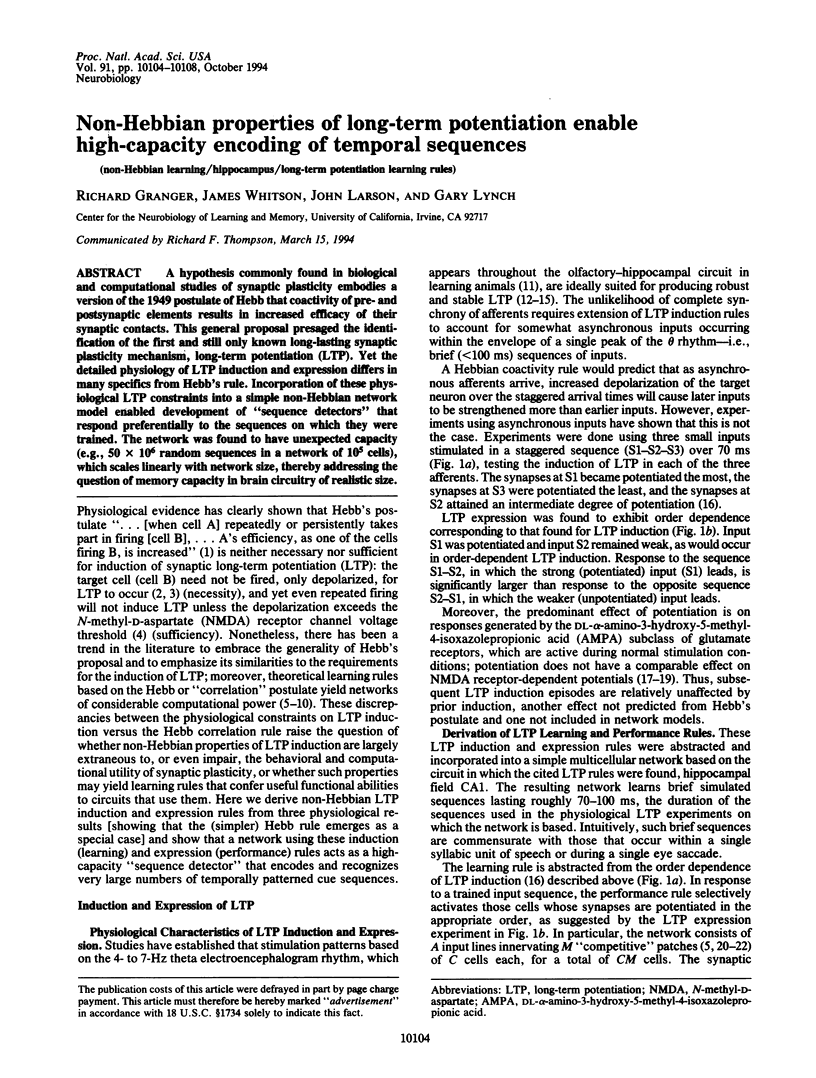
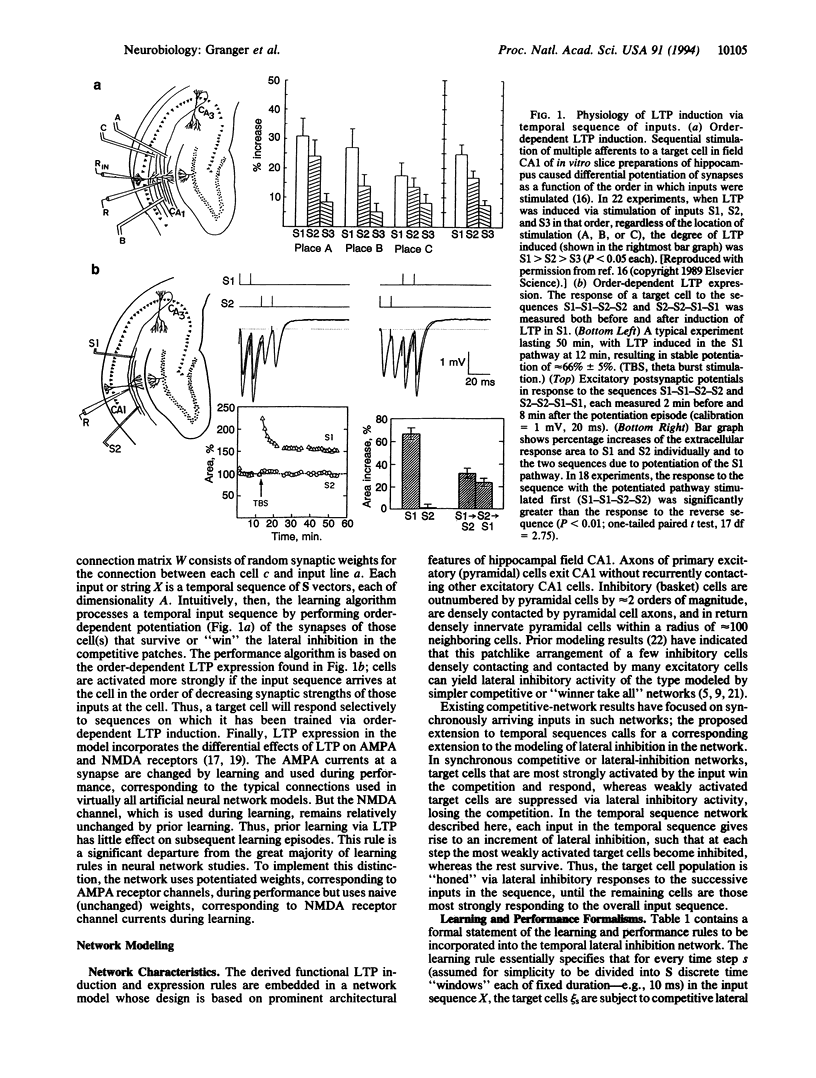
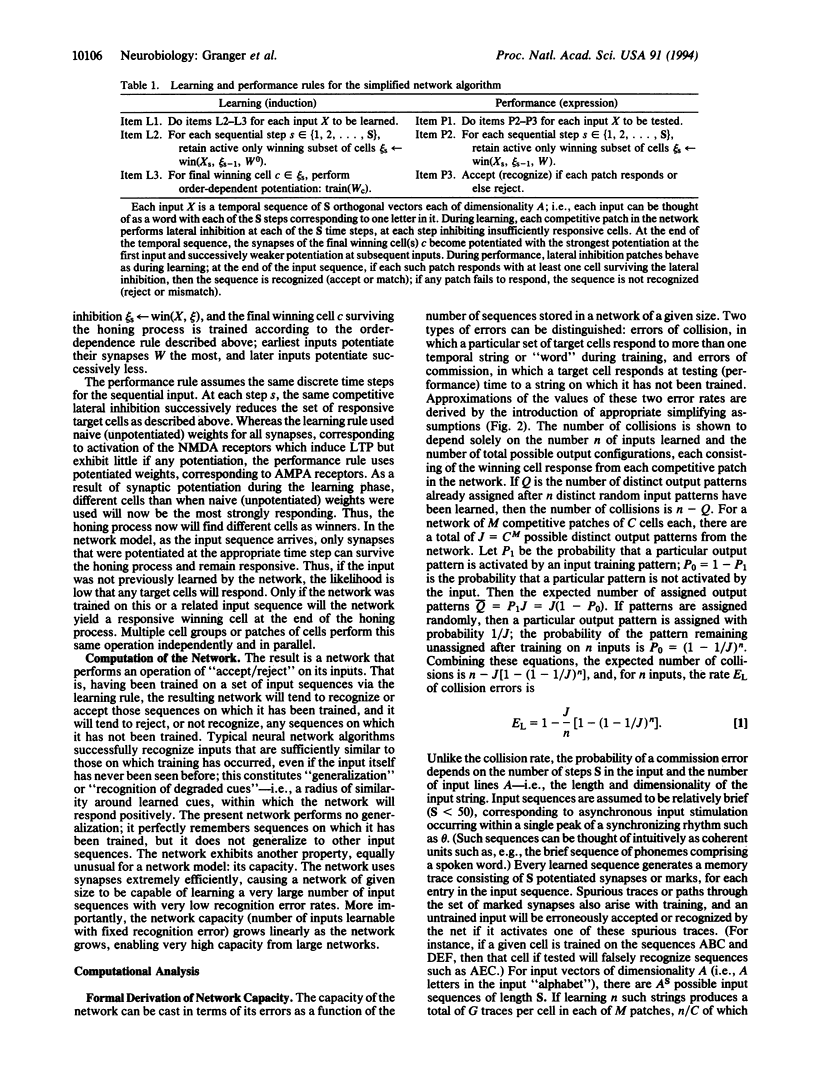
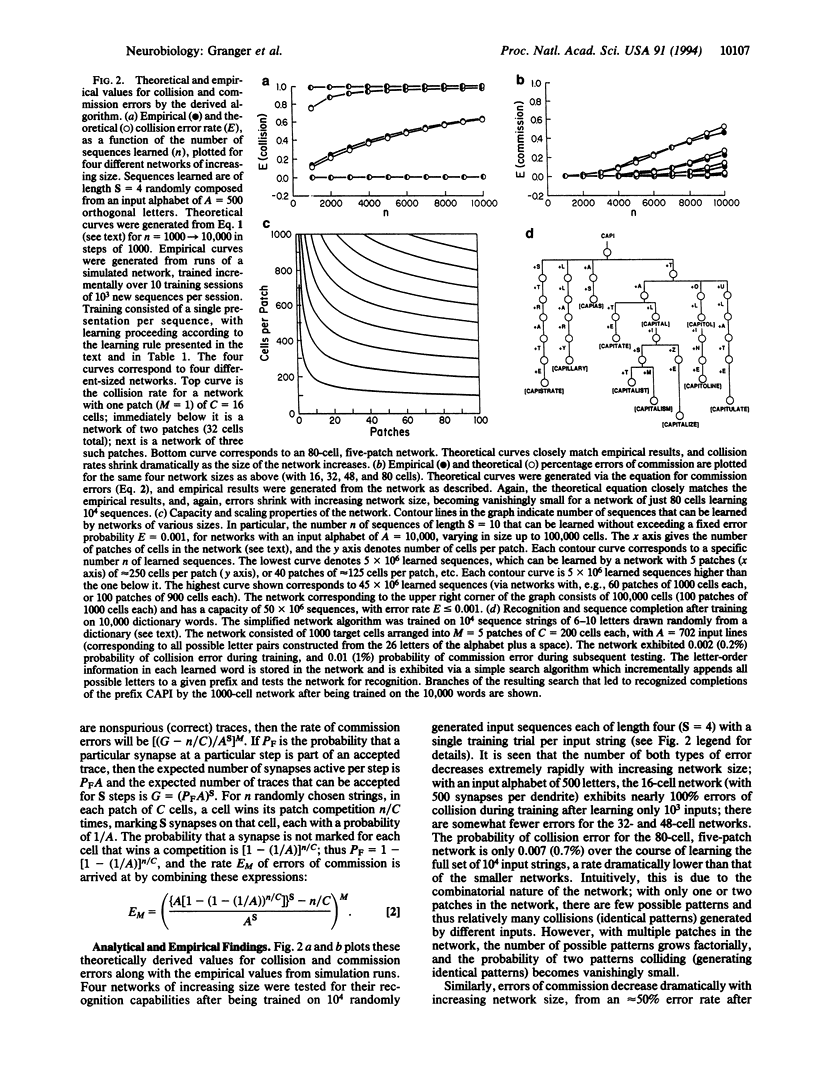
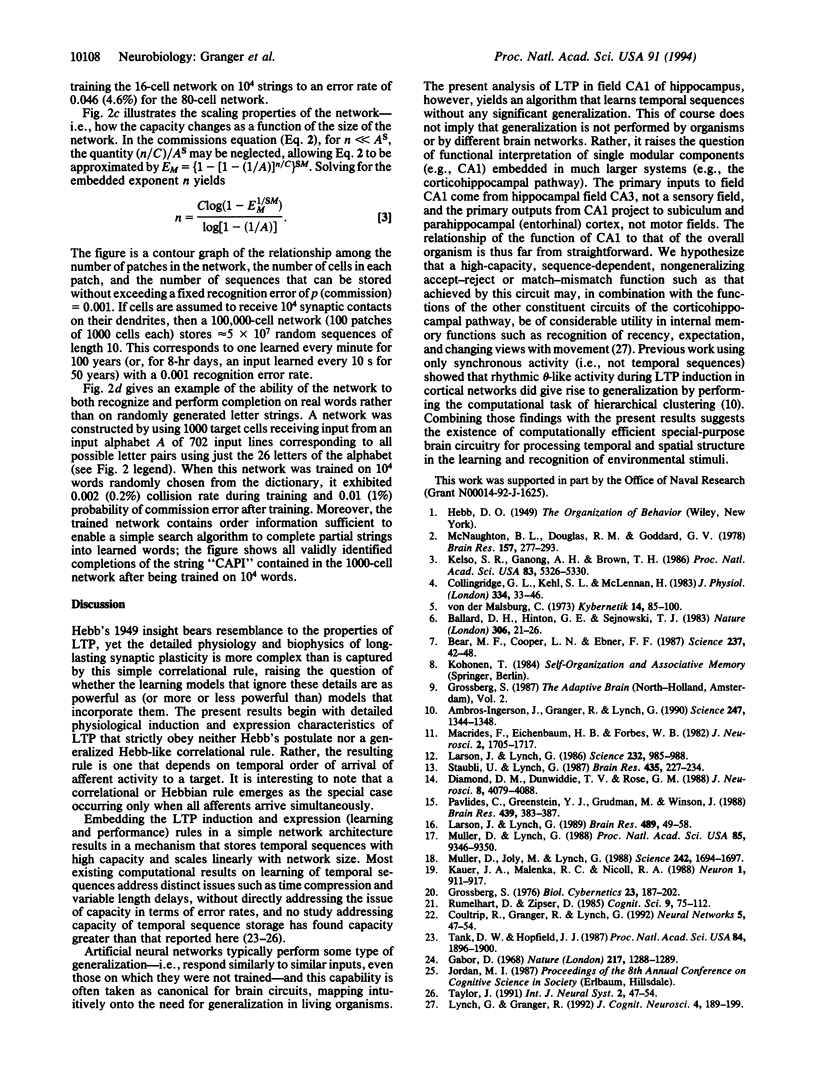
Selected References
These references are in PubMed. This may not be the complete list of references from this article.
- Ambros-Ingerson J., Granger R., Lynch G. Simulation of paleocortex performs hierarchical clustering. Science. 1990 Mar 16;247(4948):1344–1348. doi: 10.1126/science.2315702. [DOI] [PubMed] [Google Scholar]
- Ballard D. H., Hinton G. E., Sejnowski T. J. Parallel visual computation. Nature. 1983 Nov 3;306(5938):21–26. doi: 10.1038/306021a0. [DOI] [PubMed] [Google Scholar]
- Bear M. F., Cooper L. N., Ebner F. F. A physiological basis for a theory of synapse modification. Science. 1987 Jul 3;237(4810):42–48. doi: 10.1126/science.3037696. [DOI] [PubMed] [Google Scholar]
- Collingridge G. L., Kehl S. J., McLennan H. Excitatory amino acids in synaptic transmission in the Schaffer collateral-commissural pathway of the rat hippocampus. J Physiol. 1983 Jan;334:33–46. doi: 10.1113/jphysiol.1983.sp014478. [DOI] [PMC free article] [PubMed] [Google Scholar]
- Diamond D. M., Dunwiddie T. V., Rose G. M. Characteristics of hippocampal primed burst potentiation in vitro and in the awake rat. J Neurosci. 1988 Nov;8(11):4079–4088. doi: 10.1523/JNEUROSCI.08-11-04079.1988. [DOI] [PMC free article] [PubMed] [Google Scholar]
- Gabor D. Improved holographic model of temporal recall. Nature. 1968 Mar 30;217(5135):1288–1289. doi: 10.1038/2171288a0. [DOI] [PubMed] [Google Scholar]
- Grossberg S. Adaptive pattern classification and universal recoding: II. Feedback, expectation, olfaction, illusions. Biol Cybern. 1976 Aug 30;23(4):187–202. doi: 10.1007/BF00340335. [DOI] [PubMed] [Google Scholar]
- Kauer J. A., Malenka R. C., Nicoll R. A. A persistent postsynaptic modification mediates long-term potentiation in the hippocampus. Neuron. 1988 Dec;1(10):911–917. doi: 10.1016/0896-6273(88)90148-1. [DOI] [PubMed] [Google Scholar]
- Kelso S. R., Ganong A. H., Brown T. H. Hebbian synapses in hippocampus. Proc Natl Acad Sci U S A. 1986 Jul;83(14):5326–5330. doi: 10.1073/pnas.83.14.5326. [DOI] [PMC free article] [PubMed] [Google Scholar]
- Larson J., Lynch G. Induction of synaptic potentiation in hippocampus by patterned stimulation involves two events. Science. 1986 May 23;232(4753):985–988. doi: 10.1126/science.3704635. [DOI] [PubMed] [Google Scholar]
- Larson J., Lynch G. Theta pattern stimulation and the induction of LTP: the sequence in which synapses are stimulated determines the degree to which they potentiate. Brain Res. 1989 Jun 5;489(1):49–58. doi: 10.1016/0006-8993(89)90007-3. [DOI] [PubMed] [Google Scholar]
- Macrides F., Eichenbaum H. B., Forbes W. B. Temporal relationship between sniffing and the limbic theta rhythm during odor discrimination reversal learning. J Neurosci. 1982 Dec;2(12):1705–1717. doi: 10.1523/JNEUROSCI.02-12-01705.1982. [DOI] [PMC free article] [PubMed] [Google Scholar]
- McNaughton B. L., Douglas R. M., Goddard G. V. Synaptic enhancement in fascia dentata: cooperativity among coactive afferents. Brain Res. 1978 Nov 24;157(2):277–293. doi: 10.1016/0006-8993(78)90030-6. [DOI] [PubMed] [Google Scholar]
- Muller D., Joly M., Lynch G. Contributions of quisqualate and NMDA receptors to the induction and expression of LTP. Science. 1988 Dec 23;242(4886):1694–1697. doi: 10.1126/science.2904701. [DOI] [PubMed] [Google Scholar]
- Muller D., Lynch G. Long-term potentiation differentially affects two components of synaptic responses in hippocampus. Proc Natl Acad Sci U S A. 1988 Dec;85(23):9346–9350. doi: 10.1073/pnas.85.23.9346. [DOI] [PMC free article] [PubMed] [Google Scholar]
- Pavlides C., Greenstein Y. J., Grudman M., Winson J. Long-term potentiation in the dentate gyrus is induced preferentially on the positive phase of theta-rhythm. Brain Res. 1988 Jan 26;439(1-2):383–387. doi: 10.1016/0006-8993(88)91499-0. [DOI] [PubMed] [Google Scholar]
- Staubli U., Lynch G. Stable hippocampal long-term potentiation elicited by 'theta' pattern stimulation. Brain Res. 1987 Dec 1;435(1-2):227–234. doi: 10.1016/0006-8993(87)91605-2. [DOI] [PubMed] [Google Scholar]
- Tank D. W., Hopfield J. J. Neural computation by concentrating information in time. Proc Natl Acad Sci U S A. 1987 Apr;84(7):1896–1900. doi: 10.1073/pnas.84.7.1896. [DOI] [PMC free article] [PubMed] [Google Scholar]
- von der Malsburg C. Self-organization of orientation sensitive cells in the striate cortex. Kybernetik. 1973 Dec 31;14(2):85–100. doi: 10.1007/BF00288907. [DOI] [PubMed] [Google Scholar]


